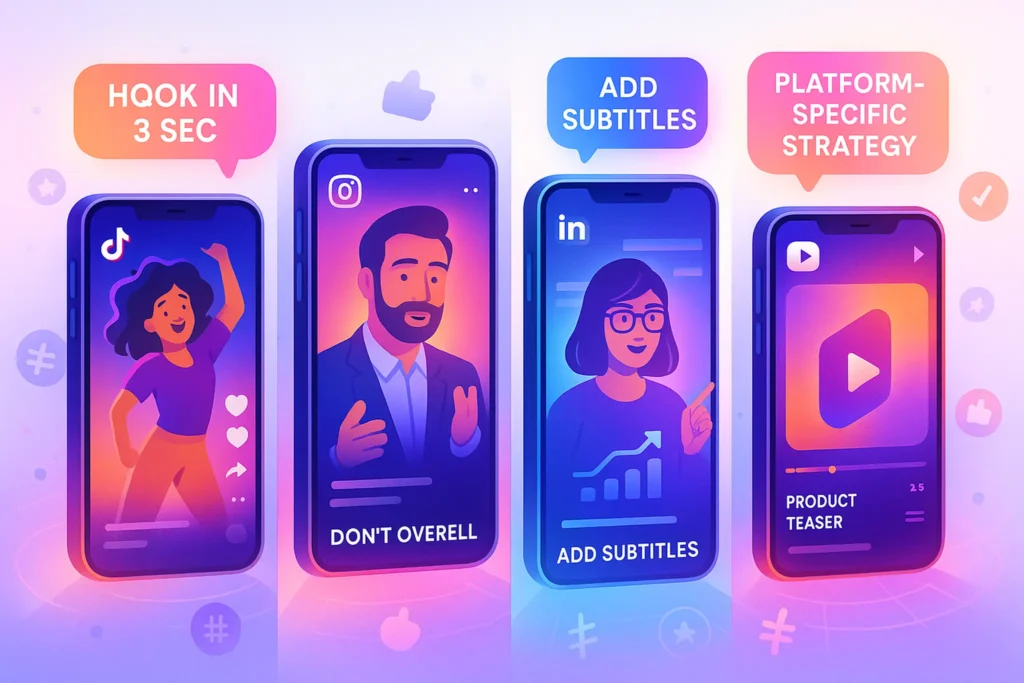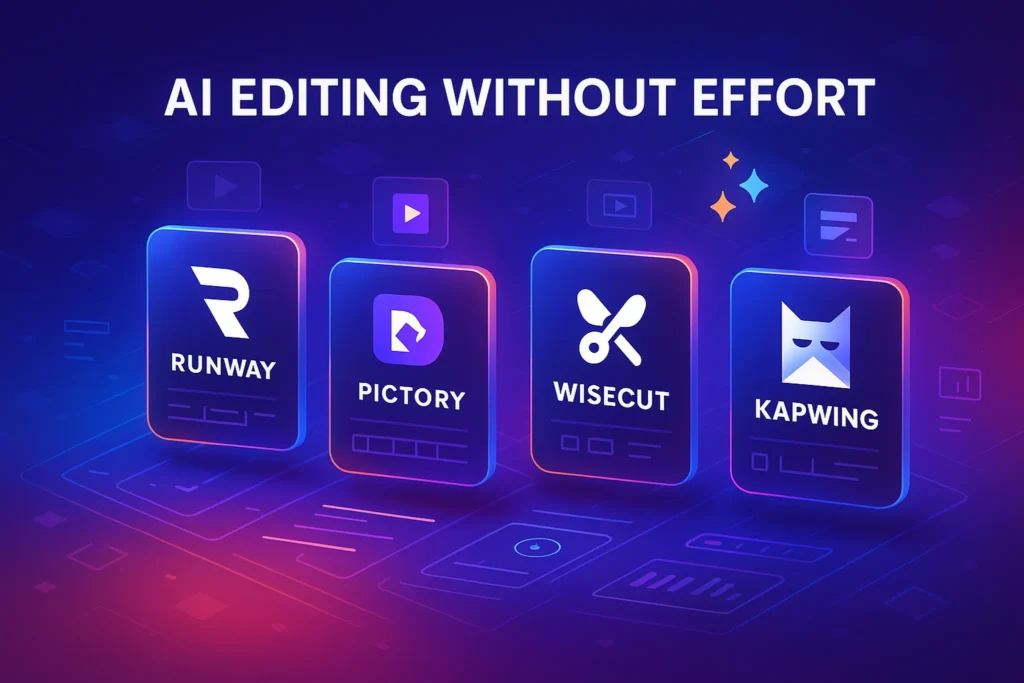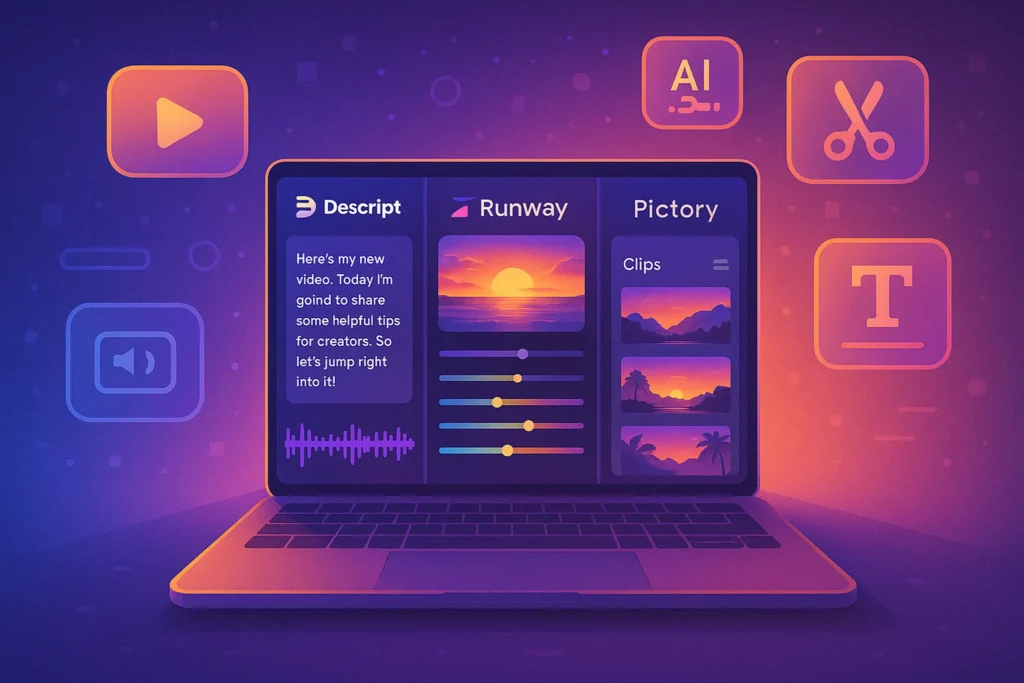-This post may contain affiliate links. If you click on one and make a purchase, I may earn a small commission at no extra cost to you.-
🎬 Introduction: Winning in the Scroll Era
Video is no longer a “nice to have” on social media—it’s the heartbeat of digital engagement. Whether you’re aiming to build brand awareness, drive traffic, or sell a product, your video strategy can make or break your success. But here’s the catch: each platform has its own rules, behaviors, and user expectations.
You can’t post the same video on TikTok, LinkedIn, and Instagram and expect it to perform equally well. What works on YouTube Shorts might flop on LinkedIn. The difference? Tone, pacing, visual style, and above all—context.
This guide gives you clear, practical Do’s and Don’ts for each major platform so your videos aren’t just seen, but remembered (and acted upon). Plus, we’ll spotlight some of the biggest rookie mistakes, lessons from viral hits, and a final checklist before you hit publish.
Ready to elevate your video game? Let’s break it down by platform.
📱 TikTok: Fast, Raw, and Relatable
TikTok isn’t about production polish—it’s about cultural fluency. Users scroll fast, expect authentic personalities, and reward content that mirrors the platform’s pace and energy.
To thrive, your videos need to match native behaviors:
-
The first 3 seconds are everything. Viewers decide instantly whether to watch or swipe away. A bold hook—like a reaction face, question overlay, or unexpected visual—can triple retention.
-
Subtitles are non-negotiable. Not just for accessibility, but to front-load the message. TikTok’s sound-off viewing habits mean your message dies if it’s not visual or text-driven.
-
Trends are your distribution engine. Participate early in sound, format, or filter trends, and contextualize them for your niche. It’s not about copying—it’s about remixing.
-
Engagement drives visibility. Ask users to comment or interact. Even a simple “Agree or nah?” in the caption can dramatically increase exposure via TikTok’s algorithm.
🎯 Do:
-
Use vertical 9:16 format with fast cuts and movement
-
Open strong: Hook viewers within the first 3 seconds
-
Add burned-in subtitles—most users watch with sound off
-
Use trending sounds and hashtags (but make it relevant)
-
Keep it real—authenticity > polish
-
Add a subtle CTA at the end (“Follow for more”, “Check the comments”)
🚫 Don’t:
-
Post overly polished or corporate content—it feels out of place
-
Ignore trends or viral formats
-
Overexplain—brevity = success
-
Upload without a caption or hook line
-
Forget to engage: Comments are gold on TikTok
👉 For more on TikTok’s impact on marketing, check out How TikTok and Reels Changed Marketing
📸 Instagram (Reels & Stories): Visual Polish with Personality
Instagram is still highly aesthetic—but increasingly fast-moving. Reels now reward consistency and motion, while Stories remain your rawest brand touchpoint.
Here’s what works:
-
Visual polish matters. Use transitions, movement, text overlays, and color grading to stand out in the scroll. First frame = click or skip.
-
Mid-video CTAs are key. Instead of saving your ask for the end, consider placing a “Save this tip 🔖” or “Try this challenge 💪” around the 40–50% mark to capture viewers before drop-off.
-
Balance promotional and value content. Avoid turning your feed into a commercial. Educational how-tos, behind-the-scenes, and story-driven clips build trust.
-
Cover design still counts. If you’re posting Reels to the main grid, the preview frame needs to align with your brand aesthetics. Think of it as your storefront.
🎯 Do:
-
Focus on eye-catching visuals and transitions
-
Use 1:1 or 9:16 format
-
Add text overlays for clarity (especially on Reels autoplay)
-
Use music and branded audio tracks wisely
-
Showcase behind-the-scenes or user-generated content
-
Insert mid-video CTAs: “Save this”, “Share with a friend”, “Try this tip”
🚫 Don’t:
-
Upload low-resolution videos—Instagram compresses hard
-
Use TikTok watermarked re-uploads (hurts reach)
-
Ignore cover images—your grid aesthetics still matter
-
Overdo filters or effects that distract from the message
🎯 LinkedIn: Thought Leadership, Not Trends
On LinkedIn, video must demonstrate value, not volume. Viewers aren’t here to be entertained (at least not primarily)—they’re here to learn, lead, or hire.
Strong content follows these patterns:
-
Lead with a challenge or insight. Start your video with a direct statement like “Most B2B video content fails because…” to engage immediately.
-
Always subtitle your video. Autoplay is muted by default, and most users watch from office environments. Burned-in captions elevate professional perception.
-
The 30-second rule. If you don’t establish your value or expertise in the first half-minute, engagement drops. Use pacing to prioritize the “what’s in it for me.”
-
Use personal storytelling. Videos that perform best are often human, not corporate. Talk about lessons learned, team experiences, or real challenges—then tie them to your product or insight.
🎯 Do:
-
Share educational, insightful, or storytelling content
-
Add captions and headline overlays for silent autoplay
-
Use subtitles for accessibility and clarity
-
Aim for 30–60 seconds max—value upfront
-
Use professional tone, but show personality
-
CTA should align with B2B goals (visit site, download guide, etc.)
🚫 Don’t:
-
Post TikTok-style humor unless it directly relates to your niche
-
Lead with clickbait or aggressive sales pitches
-
Post long unedited rants—cut to the point
-
Skip captions—sound-off is default
▶️ YouTube Shorts: Blend of Entertainment & Education
Shorts is YouTube’s direct answer to TikTok—and its growth is explosive. However, YouTube users have slightly different expectations than TikTok users.
Here’s how to play the format right:
-
Hook instantly, then pay it off. Start with a question or cliffhanger: “Here’s why your videos aren’t converting 👇” then deliver a tight explanation.
-
Optimize the first 3 seconds visually. Use B-roll, animated captions, or overlays that create instant curiosity.
-
Think in themes. Viewers love bingeable sequences like “1 tip per day” or “X myths debunked.” Build series, not just standalones.
-
Repurpose with finesse. Cut down long YouTube tutorials into 30-second teaser clips that solve one micro problem. Then link to the full video in the description.
Also, don’t underestimate thumbnails—even for Shorts. YouTube still surfaces them in search results and mobile previews.
🎯 Do:
-
Hook immediately with bold visuals or a strong statement
-
Use high-quality vertical format (1080×1920)
-
Keep it fast-paced—each second matters
-
Repurpose snippets from long-form content
-
Optimize title and description with keywords
-
Encourage interaction: “What do you think?”, “Agree or disagree?”
🚫 Don’t:
-
Upload blurry or shaky footage
-
Stuff the video with too much info—simplify
-
Use long intros or outros—no time for fluff
-
Neglect the comment section—engagement fuels reach
🔁 Want to learn how to reformat your desktop content for mobile-first platforms? Read Optimizing Video Content for Mobile Viewers
🚫 Common Mistakes Beginners Make
1. Treating all platforms the same
Many beginners believe video is universal—but each platform has a unique rhythm and user intent. A 60-second product teaser may work on YouTube Shorts but will feel slow on TikTok. A corporate B2B pitch may shine on LinkedIn, but flop on Instagram.
🔍 Root cause: Lack of platform-specific research.
✅ Solution: Watch top-performing videos on each platform for a week and take notes on length, tone, hook style, captions, and trends.
2. Posting without context
A product demo with no intro or call-to-action feels like a random video. Viewers need framing: What is this? Why should I care? What should I do next?
🔍 Root cause: Creator-focused, not viewer-focused.
✅ Solution: Use 5-second framing hooks like “Struggling to grow on LinkedIn? Try this…” before diving into content.
3. Ignoring mobile viewing behaviors
Most social videos are consumed vertically, silently, and in motion. Beginners who upload widescreen, narration-only content miss the mark completely.
🔍 Root cause: Editing for desktop or YouTube, then repurposing lazily.
✅ Solution: Embrace native formats (9:16), use visual cues and captions, and test playback on mobile before publishing.
4. Overselling without value
The worst-performing videos start with “Buy now” or “We’re the best.” Viewers instantly scroll away. The first impression should solve a problem, not pitch a product.
🔍 Root cause: Brand-centric instead of value-driven thinking.
✅ Solution: Lead with pain points, relatable stories, or how-to tips. Sell by not selling.
5. Uploading blurry, poorly lit, or pixelated videos
In the age of 4K smartphones, low-res videos destroy trust. Even free editing apps like InShot offer HD export.
🔍 Root cause: Rushed workflow or wrong export settings.
✅ Solution: Record in daylight or with proper lighting, and always export in 1080p or higher for social platforms.
Many marketers dive into social video without understanding the platform-specific dynamics—and it shows. These common missteps can tank even the most creative ideas:
-
Same video across all platforms: Posting a 16:9 YouTube promo on TikTok or Reels without reformatting? Instant scroll-past.
-
No subtitles or context: Most viewers watch muted. If your video relies solely on narration, you’re invisible.
-
Hard-sell messaging: Social is about connection, not commercials. Overselling kills trust.
-
Low resolution uploads: Blurry videos = unprofessional perception. Always export in HD.
-
Ignoring trends or timing: Posting off-trend or missing peak activity hours can bury even great content.
-
No clear CTA: Viewers need direction. End your videos with what you want them to do next—comment, click, save, or share.
🧠 Nerd Tip: If you’re just getting started, make sure you also review our guide on Using Live Video to Engage Your Audience for real-time interaction strategies.
📊 Lessons from Viral Campaigns
1. Duolingo on TikTok: Bold Brand Voice, Zero Fear
Duolingo’s viral success wasn’t just because of their owl mascot—it was because they allowed that mascot to become chaotic, humorous, and self-aware in a way that aligned with Gen Z humor. No product pushing, just platform fluency.
🎯 Key Takeaway: Empower your social team to act like creators, not ad agencies. Brand voice evolves by listening—not scripting.
2. Gymshark on Instagram: Community + Creator Collabs
Gymshark mastered the art of using fitness creators for Reels that feel native, inspiring, and community-driven. Their videos often have no direct sales pitch—but drive massive conversion through emotional relevance and trust.
🎯 Key Takeaway: UGC-style content outperforms studio shoots when done with authenticity. People trust peers more than polished logos.
3. Adobe Express on YouTube Shorts: Micro-education with Hooks
Adobe created high-performing Shorts that offered tiny tutorials—e.g., “How to remove background in 5 seconds.” Each video delivers one bite-sized win, fast and clearly.
🎯 Key Takeaway: Don’t overwhelm. Deliver one tip, one trick, or one moment of clarity per video. Stack value, don’t dump info.
Some of the most memorable social video campaigns weren’t high-budget—they were deeply aligned with audience behavior. Here’s what they got right:
-
Duolingo (TikTok): Embraced platform humor, leaned into mascot personality, and used reactive content to stay relevant. Result? Millions of organic views and cultural presence.
-
Gymshark (Instagram Reels): Consistent branded visuals + creator partnerships = viral reach with real sales.
-
Adobe Express (YouTube Shorts): Tutorial-style content offering value in under 60 seconds. Hook, teach, CTA—all within a single short-form package.
💬 QUOTE:
“We didn’t go viral by being flashy—we went viral by acting like users, not advertisers.”
— Zaria Parvez, Global Social Lead, Duolingo
✅ Pre-Publish Checklist
Before hitting that “Post” button, run through this quick checklist to make sure your content is optimized:
✅ Is the format native to the platform?
A horizontal video on TikTok wastes space. Use 9:16 for mobile-first platforms, 1:1 for Instagram Grid, and 16:9 only where appropriate (e.g., YouTube long-form).
✅ Does the first 3 seconds create curiosity?
Your hook should either ask a question, show an unexpected visual, or tease the payoff. If your video starts with branding or fades—you’re losing viewers.
✅ Are captions visible and styled correctly?
Use bold, high-contrast fonts. Avoid fancy transitions or overlays that clash with readability. Keep lines short and centered if possible.
✅ Is the message understandable even with sound off?
Try muting your video and watching it. If you can’t grasp the story without audio—add more text overlays or on-screen guidance.
✅ Have you embedded a call-to-action inside the content?
Don’t leave CTAs to the last second. Most viewers don’t finish videos. Insert “Save this,” “Follow for Part 2,” or “Check the comments” mid-way.
✅ Did you test playback on a real phone?
Always preview your post on your smartphone to check spacing, visibility, and flow. What looks good on desktop might fail on mobile screens.
✅ Are you emotionally aligned with your audience?
Tone mismatch is one of the most invisible killers. A hyper-enthusiastic ad on LinkedIn? A stiff product walkthrough on TikTok? Both are DOA.
-
Is the format tailored to the platform? (Vertical for Reels, LinkedIn subtitles, etc.)
-
Does the first 3 seconds grab attention visually or emotionally?
-
Are captions/subtitles included and readable?
-
Did you compress or resize the video for fast loading?
-
Is there a clear, platform-relevant CTA?
-
Did you test the thumbnail (where applicable)?
-
Have you included relevant hashtags or tags for discovery?
-
Is the tone aligned with your brand and platform culture?
🎥 Bonus: For more tips on getting your videos ranked higher, explore How to Rank Your Videos
🧠 Nerd Verdict: One Size Doesn’t Fit All
Here’s the truth: the days of cross-posting the same video everywhere are over. Social platforms are unique ecosystems, and what thrives on one might flop on another.
-
TikTok rewards raw energy and cultural relevance
-
Instagram wants visually engaging polish with clear hooks
-
LinkedIn demands professional value and clarity
-
YouTube Shorts favors fast, clean, high-impact snippets
Treating your video content like a chameleon—not a billboard—is the key to success. That means planning hooks per platform, embedding native captions, using formats that fit, and mastering the unspoken language of each space.
Use the Do’s to build trust and traction. Avoid the Don’ts to prevent embarrassment or invisibility. And always stay flexible—because what worked last month might not work next week.
Want to make every video count? Then strategize like a platform-native, not a copy-paster.
❓ FAQ: Nerds Ask, We Answer
💬 Would You Bite?
Which platform do you struggle with most when it comes to video marketing?
TikTok’s chaos? LinkedIn’s formality? Or maybe you’re unsure how to repurpose content across channels?
Drop your challenge—or your best tip—in the comments 👇
Let’s learn from each other.



